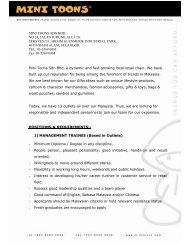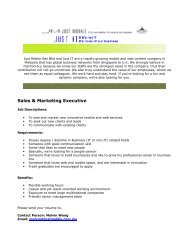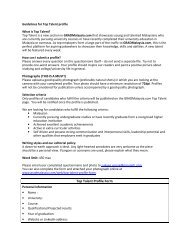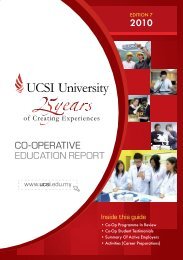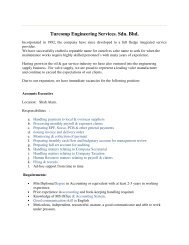MP491/6-Undergraduate Research Project Proposal 1. Title ... - UCSI
MP491/6-Undergraduate Research Project Proposal 1. Title ... - UCSI
MP491/6-Undergraduate Research Project Proposal 1. Title ... - UCSI
Create successful ePaper yourself
Turn your PDF publications into a flip-book with our unique Google optimized e-Paper software.
2. <strong>Title</strong>: Antimicrobial Susceptibility Testing of Murraya koenigii extract on<br />
Staphylococcus aureus<br />
Supervisor(s)<br />
Main: Ms Priya<br />
Co- : Dr. Thet Thet Htar<br />
Objective(s)<br />
<strong>1.</strong> To determine the minimal inhibitory concentration value using disk diffusion method<br />
and microdilution assay on Staphylococcus aureus cultures.<br />
Abstract<br />
Natural products have shown that they are potential source of antimicrobial<br />
agents, such as neem leaves and curry leaves. Since antimicrobial therapy is going<br />
through a crisis with the increasing resistance towards antimicrobial agents, it is<br />
important to screen new plants and study their effectiveness in their antimicrobial<br />
activities.<br />
Staphylococcus aureus, gram positive bacteria that typically occur in grape-like<br />
clusters have yellow pigmented colonies. They seem to be the most pathogenic of all the<br />
staphylococci and are often a problem in the hospital environment. Infections by<br />
staphylococci have become difficult to treat as they have become resistant to many<br />
antibiotics that are exposed in the hospital environment. Folliculitis, food poisoning, toxic<br />
shock syndrome, impetigo are some of the diseases caused by S. aureus strains.<br />
3. <strong>Title</strong>: Sub-chronic (28 days) toxicity study of Limonia acidissima bark extract in rats.<br />
Supervisor(s)<br />
Main: Dr. Chin Jin Han<br />
Co-: Dr. Gabriel Akowuah<br />
Objective(s)<br />
<strong>1.</strong> To examine the possible toxic or adverse effect of L. acidissima bark extract in rats.<br />
2. To determine LD 50 of Limonia acidissima extract.<br />
Abstract<br />
Limonia acidissima (Rutaceae) is commonly known as wood apple (locally<br />
named belinggai), is distributed in dry warm regions of Burma, India, Malaya and Sri<br />
Lanka. Oil and constituents derived from the leave, bark, roots and fruit pulp are used as<br />
topical application on venomous wounds and against snakebite. An interesting feature of<br />
the plants classified within the family Rutaceae is that they contain several types of<br />
cytotoxic, antimicrobial, neuroactive quinoleic alkaloids derived from anthranilic acid. The<br />
plant has been reported to contain limonoids in stem bark and root bark, alkaloids,<br />
benzoquinone, flavonoids, triterpenoids in root bark, stem bark, leaves and fruits.<br />
However, toxicity studies on this plant have not been reported extensively. Therefore,<br />
this study aims to ensure the safe use of this plant for therapeutic purposes.<br />
2






